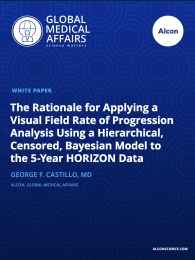

KEY TAKEAWAY POINTS
• The clinical relevance of visual fields has progressed over time, and is a relevant functional indicator of the status of a patient’s glaucoma
• Standardized automated perimetry has been an essential tool to help best guide disease management for glaucoma patients
• Several models beyond those found within standardized automated perimetry have attempted to better predict progression of visual field loss
• A hierarchical model that has the ability to describe the rates of progression between groups as well as at Garway-Heath clusters and point locations, and that accounts for censoring of 0 dB readings may provide practical advantages and can identify deeper insight into identified patterns of visual field loss
• A model by Montesano et al that was used in the Laser in Glaucoma and Ocular Hypertension Trial (LiGHT) and Treatment of Advanced Glaucoma Study (TAGS) was applied in a retrospective, post-hoc manner to the 5-year visual field data of the HORIZON Trial.
• This post-hoc analysis revealed a difference in the rate of progression between groups, but it was apparent that there were a greater number of fast progressors in the cataract surgery-alone group that could account for these differences.
• A number of limitations to this analysis must be understood to interpret these findings within context


